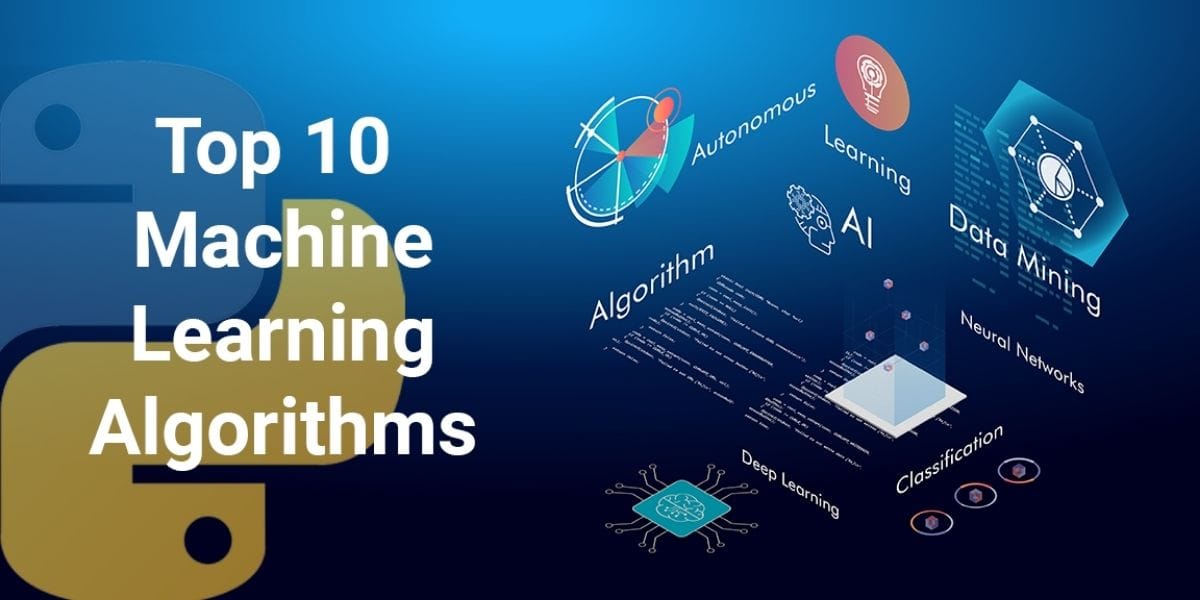10 Best Machine Learning Algorithms You Must Know

Machine learning (ML) has revolutionized industries by enabling systems to learn from data and make predictions or decisions autonomously. At the heart of this transformation are powerful algorithms that drive the learning process.
Below is a detailed exploration of the top 10 machine learning algorithms, their functionalities, and applications.
1. Linear Regression
Linear Regression is one of the simplest and most interpretable algorithms in machine learning. It models a linear relationship between independent variables (features) and a dependent variable (target). The algorithm predicts continuous outcomes, making it ideal for regression tasks.
Key Features:
- Establishes a linear relationship between input features and target variables.
- Easy to implement and interpret.
- Requires minimal tuning.
Applications:
- Predicting housing prices based on location, size, and amenities.
- Estimating sales revenue in business forecasting.
- Risk assessment in insurance and finance sectors
2. Logistic Regression
Logistic Regression is used for binary classification problems. Instead of predicting a continuous value, it predicts probabilities that map to discrete classes using a sigmoid function.
Key Features:
- Works well with linearly separable data.
- Outputs probabilities for classification tasks.
- Simple yet effective for binary or multi-class classification.
Applications:
- Fraud detection in banking systems.
- Disease diagnosis in healthcare.
- Customer churn prediction
3. Decision Trees
Decision Trees are versatile algorithms that split data into subsets based on feature values. They create a tree-like structure where each node represents a decision based on input features.
Key Features:
- Easy to visualize and interpret.
- Handles both classification and regression tasks.
- Prone to overfitting but can be mitigated using ensemble methods like Random Forest.
Applications:
- Credit scoring in finance.
- Customer segmentation in marketing.
- Healthcare decision support systems
4. Random Forest
Random Forest is an ensemble learning method that combines multiple decision trees to enhance accuracy and robustness. It mitigates overfitting by averaging predictions from multiple trees trained on random subsets of data.
Key Features:
- Reduces overfitting compared to individual decision trees.
- Handles large datasets efficiently.
- Suitable for both classification and regression tasks.
Applications:
- E-commerce product recommendations.
- Disease detection in medical diagnostics.
- Feature selection in predictive modeling
5. Support Vector Machines (SVM)
SVM is a powerful algorithm for both classification and regression tasks. It works by finding the optimal hyperplane that separates different classes in the input space, making it effective for high-dimensional datasets.
Key Features:
- Effective for small datasets with complex boundaries.
- Works well with high-dimensional data.
- Can use kernel functions for non-linear problems.
Applications:
- Image recognition and classification.
- Spam filtering in email systems.
- Sentiment analysis in text data
6. K-Means Clustering
K-Means is an unsupervised learning algorithm used for clustering tasks. It partitions data into $$k$$ clusters based on feature similarity, minimizing intra-cluster variance.
Key Features:
- Efficient for large datasets.
- Requires specification of the number of clusters ($$k$$).
- Sensitive to initial cluster centroids.
Applications:
- Customer segmentation in marketing analytics.
- Anomaly detection in cybersecurity.
- Grouping similar products or services
7. Naïve Bayes Classifier
Naïve Bayes is a probabilistic classifier based on Bayes' theorem, assuming conditional independence between features. Despite its simplicity, it performs remarkably well on text classification tasks.
Key Features:
- Fast and reliable for large datasets.
- Works well with categorical data.
- Assumes independence among features, which may not always hold true.
Applications:
- Email spam filtering systems.
- Document categorization (e.g., news articles).
- Disease prediction models
8. Artificial Neural Networks (ANNs)
ANNs are inspired by biological neural networks and consist of interconnected nodes (neurons). They are highly flexible and can model complex relationships between inputs and outputs.
Key Features:
- Capable of handling non-linear relationships between features.
- Improves performance with larger datasets.
- Requires significant computational resources for training.
Applications:
- Speech recognition (e.g., Siri or Alexa).
- Stock market prediction models.
- Image compression techniques
9. Gradient Boosting Algorithms (e.g., AdaBoost)
Gradient Boosting algorithms build models sequentially, correcting errors made by previous models. AdaBoost focuses on improving weak classifiers by assigning weights to misclassified instances during training.
Key Features:
- Combines multiple weak learners into a strong learner.
- Effective for both regression and classification tasks.
- Prone to overfitting if not tuned properly.
Applications:
- Predicting customer churn rates in businesses.
- Medical diagnosis based on patient data.
- Topic modeling in customer feedback analysis
10. Convolutional Neural Networks (CNNs)
CNNs are specialized deep learning algorithms designed for image processing tasks. They use convolutional layers to extract spatial features from images effectively.
Key Features:
- Excels at recognizing patterns in images or videos.
- Reduces dimensionality while preserving essential information through pooling layers.
- Requires large datasets for training effectively.
Applications:
- Facial recognition systems (e.g., security applications).
- Object detection in autonomous vehicles (e.g., Tesla).
- Medical imaging analysis
Conclusion
Machine learning algorithms are foundational to modern AI applications across industries such as healthcare, finance, e-commerce, and cybersecurity. Each algorithm has unique strengths suited to specific problem types, emphasizing the importance of choosing the right model based on your dataset and objectives.